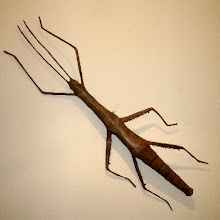1. Shells painted after they are stuck down.
The preferred Italian Renaissance method was apparently to make a drawing on a panel, then fill in with eggshells, laying them out in sections according to the drawing. Each section was then painted a particular color.
In a similar contemporary technique, shells are stuck down in well defined, separate areas of a drawing, and then each area is painted a single color, usually with acrylic paints. The result is a bold image composed of sharply defined blocks of color. The color is of course on the surface of the shell, so it has a different look from a mosaic pieced together from dyed shells, where the colors sit deeper and vary in tone and saturation. Typically the surface that the shells are to be applied to is painted, and the paint shows through between the shell bits, simulating grout.
A variation of this is to cover a surface evenly with eggshells, then paint a design directly over them with little regard to the pattern of the eggshells. The textured surface simulates the texture of a mosaic, and the paint doesn’t follow the pattern of individual shell bits. There are artists today who work with this technique with very nice results, but to me this is more about the painting than it is about mosaic.
2. Shells painted before they are stuck down.
The shells are painted with (usually) acrylic paint before they are broken and stuck down. This can produce either a mosaic with sharply separated areas of color, or else more complex pictures with shells painted in subtle variety of tone and saturation before they are broken and then carefully selected and placed to produce light, shadow, depth and gradations of tone.
3. Shells dyed before they are stuck down.
Eggshells take dye differently from shell to shell (and even different areas of the same shell) because of subtle differences in the structure and color of the shell. They vary quite a bit in tone and depth of color, resulting in a mosaic that looks more “textured”. These can be carefully selected and placed for variations in lightness and hue (see the very “painterly” mosaics of Mrs. Garren), or laid out in subtly mottled and textured blocks of color.
I plan on trying a few painting techniques later on, but for now I’m concentrating on dye. I’ll be testing several different dyes for color saturation, ease of use, overall appearance, and colorfastness. Supposedly it makes a difference if you use shells from fresh or boiled eggs, so I’ll be testing both.
The contenders are:
Easter egg dye. Essentially food dye in tablet form. Also tends towards the pastel.
Pysanky dye. This is the dye used for Ukranian Easter eggs. It is much richer than food color or commercial Easter egg dye.
Fabric dye. RIT is the most readily available in my area, but Tintex was mentioned specifically in one article as the thing to use.
Results to follow...






No comments:
Post a Comment